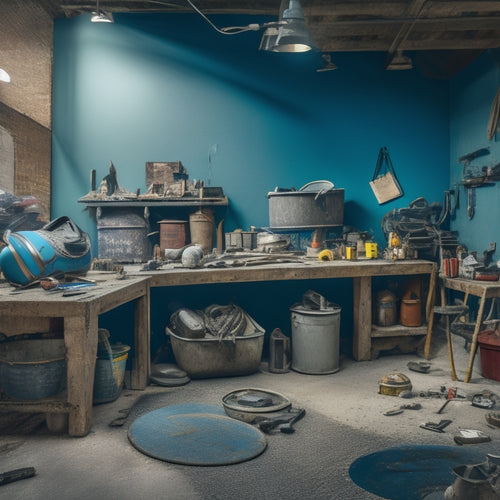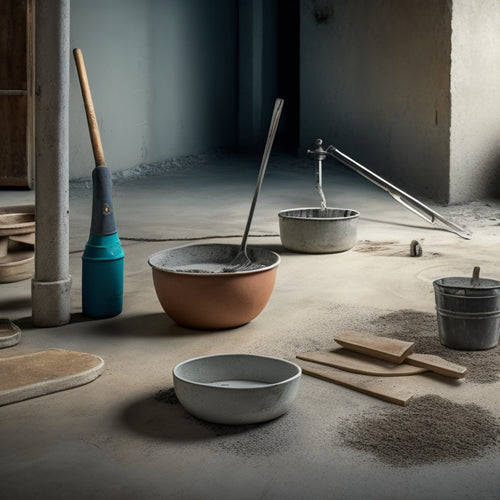
Tools and Equipment for Laying Concrete Blocks
Share
When laying concrete blocks, you'll need a range of essential hand tools, including trowels, block spacers, and jointers, to guarantee accuracy and efficiency. Measuring and leveling tools like tape measures and spirit levels are also vital for achieving precise measurements and alignment. Cutting and shaping tools, such as diamond-blade saws and grinders, will help you refine the shape and surface of the blocks. Mixing and pouring tools, like concrete mixers and pouring buckets, will aid in preparing and transporting the concrete. Finally, finishing and smoothing tools, including finishing trowels and concrete floats, will help you achieve a professional-looking finish.
Key Takeaways
• Essential hand tools for block work include trowels, block spacers, and jointers, ensuring uniform joints and professional results.
• Measuring and leveling tools, such as tape measures and spirit levels, ensure accurate measurements and alignment.
• Cutting and shaping tools, including diamond-blade saws and grinders, are necessary for precise cuts and smooth edges.
• Mixing and pouring tools, like concrete mixers and pouring buckets, help achieve the right consistency and smooth concrete surfaces.
• Finishing and smoothing tools, including finishing trowels and steel trowels, are vital for achieving desired surface textures and a uniform finish.
Essential Hand Tools for Block Work
You'll need a set of essential hand tools to secure efficient and accurate block work, including a level, trowel, and jointer.
A trowel is an important tool for applying and smoothing mortar, and you'll want to choose the right type for the job. There are three main trowel types: pointing, notched, and square-edged. Pointing trowels are ideal for applying small amounts of mortar, while notched trowels are better suited for larger areas. Square-edged trowels are perfect for smoothing and finishing.
In addition to a trowel, you'll need block spacers to guarantee uniform joints and maintain structural integrity. Block spacers come in various sizes and materials, so select the ones that match your block dimensions and project requirements.
A jointer is another essential tool that helps to finish and smooth joints. By having these essential hand tools in your arsenal, you'll be able to achieve professional-looking results and secure a strong, durable structure.
With the right tools, you'll be able to work efficiently and confidently, assuring a successful block-laying project.
Measuring and Leveling Tools
Accurate measurements and precise leveling are crucial to a successful block-laying project, and a set of reliable measuring and leveling tools is indispensable to achieving this goal.
You'll need tools that can help you take precise measurements and guarantee your blocks are laid level and plumb. A 25-foot tape measure or a laser distance meter will come in handy for measuring distances and widths.
For leveling, you'll need a spirit level, a torpedo level, or a digital level to guarantee your blocks are perfectly horizontal and vertical.
When it comes to measuring techniques, you'll want to use a combination of straightedge and square to guarantee your corners are precise and your walls are straight.
For leveling methods, you can use a string line and a level to establish a level plane, or a laser level to project a level line.
Cutting and Shaping Tools
To make precise cuts and shapes in concrete blocks, you're going to need a range of cutting and shaping tools that can handle the demands of this critical stage in the block-laying process.
The type of saw you choose will depend on the specific task at hand. For instance, a diamond-blade saw is ideal for making straight cuts, while a masonry saw is better suited for curved cuts. You may also need a tile saw or a circular saw for more intricate cuts.
In addition to saws, you'll need a variety of shaping techniques to achieve the desired shape and fit. Chiseling and grinding are essential for removing excess material and smoothing out rough edges. A hammer and chisel can be used to break away small pieces of concrete, while a grinder can be used to refine the shape and surface.
Remember to always follow safety guidelines when working with cutting and shaping tools, and make sure you have the necessary protective gear, such as gloves and safety glasses.
With the right tools and techniques, you'll be able to achieve precise cuts and shapes that fit together seamlessly, ensuring a strong and durable concrete block structure.
Mixing and Pouring Tools
Mixing and pouring concrete requires precise control over the ratio of cement to aggregate and water, making high-quality mixing and pouring tools essential for achieving the right consistency and strength. As you prepare to lay concrete blocks, you'll need to master various mixing techniques and pouring methods to guarantee a strong and durable structure.
To achieve ideal results, you'll need the right tools for the job. Here are some essential mixing and pouring tools you should consider:
| Tool | Description |
|---|---|
| Concrete Mixer | A mechanical mixer that combines cement, aggregate, and water to the right consistency |
| Mixing Paddle | A handheld tool used to mix small batches of concrete |
| Pouring Bucket | A large, heavy-duty bucket used to transport and pour concrete |
| Tamping Tool | A tool used to compact and level freshly poured concrete |
| Screed Board | A long, flat board used to smooth and level concrete surfaces |
Finishing and Smoothing Tools
You'll need to employ a range of specialized tools to finish and smooth the concrete surface, ensuring a professional-looking result that meets your project's specifications.
A finishing trowel is vital for achieving the desired surface textures. You'll use it to apply pressure and manipulate the concrete to create the desired finish. Developing effective trowel techniques takes practice, so be prepared to experiment and refine your skills.
A concrete float is another important tool for smoothing out the surface. It helps to remove excess water and even out the concrete, creating a uniform surface.
For more intricate work, a hand float or edger is ideal for getting into tight spaces and creating sharp, defined edges. A steel trowel is also useful for creating a smooth, even finish.
Frequently Asked Questions
What Safety Precautions Should I Take When Working With Concrete Blocks?
When working with concrete blocks, you should take specific safety precautions to avoid injuries.
First, wear proper footwear with good traction to prevent slips and falls.
Next, use correct lifting techniques to avoid straining your back, bending at the knees and lifting with your legs.
Additionally, wear gloves to protect your hands from abrasions and cuts.
Can I Use a Block Splitter on Frozen or Wet Blocks?
Did you know that the global concrete block market is projected to reach $1.4 billion by 2025?
Now, about using a block splitter on frozen or wet blocks: you shouldn't do it.
Frozen blocks can shatter and cause injuries, while wet blocks may crumble, making them difficult to split accurately.
Instead, focus on proper block splitting techniques, such as scoring and breaking, and make certain you're handling frozen blocks with care, thawing them slowly to avoid damage.
How Do I Clean and Maintain My Block-Laying Tools?
You'll want to prioritize cleaning and maintaining your tools to guarantee they remain in peak condition.
Start by establishing a maintenance schedule to regularly inspect and clean your tools.
Store them in a dry, organized space, like a designated tool storage area.
Remove any debris, wipe down surfaces, and apply a rust-inhibiting coating to metal components.
Are There Any Specific Regulations for Laying Concrete Blocks in My Area?
Did you know that over 600,000 new homes are built in the US each year, with concrete blocks being a popular choice?
When laying concrete blocks in your area, you'll want to check local building codes and zoning regulations to guarantee compliance.
You can start by visiting your city's planning department website or consulting with a local building inspector to obtain specific guidelines.
Failure to comply can result in costly rework or even project shutdown.
Can I Reuse Old or Broken Concrete Blocks in My Project?
You're considering reusing old or broken concrete blocks in your project, but you should exercise caution.
Reusing blocks can compromise their integrity, leading to structural issues down the line.
Additionally, aesthetic considerations come into play, as old or broken blocks may not match the appearance of new ones, affecting the overall look of your project.
It's crucial to inspect each block carefully and weigh the potential risks against any cost savings.
Conclusion
With the right arsenal of tools and equipment, you'll be well on your way to laying concrete blocks like a pro.
Remember, precision is key - a single misstep can compromise the integrity of your entire structure.
So, don't skimp on the essentials: level, align, and smooth with care, for a foundation that's as solid as a rock.
After all, a strong foundation is the cornerstone of any successful project, and with these tools, you'll be building on bedrock.
Related Posts
-

What Tools Do I Need for Concrete Wall Repair
As you prepare for a concrete wall repair job, you'll need a variety of tools to guarantee a successful outcome. Star...
-

What Tools Do You Need for Concrete Flooring
You'll need a thorough arsenal of specialized tools to achieve a high-quality, professional-looking concrete floor, i...
-

Why You Need These Concrete Overlay Tools
When tackling a concrete overlay project, you need the right tools to achieve a flawless finish and avoid costly mist...


